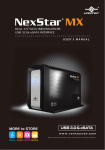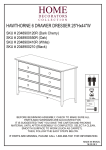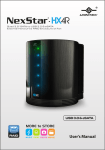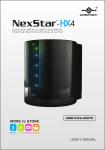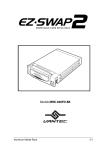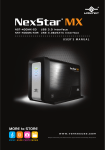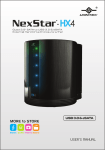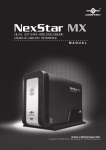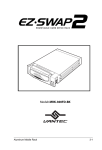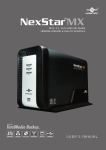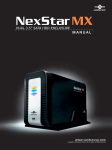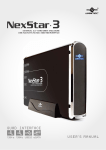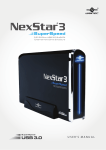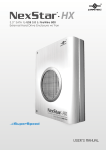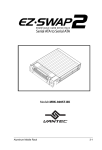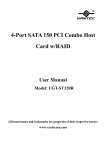Download Vantec NexStar-HX2R
Transcript
User’s Manual Package Contents: Dual 3.5” SATA to USB 3.0 & eSATA External Hard Drive RAID Enclosure w/ Fan 1 2 3 4 5 6 7 NexStar HX2R Enclosure USB 3.0 Cable eSATA Cable Power Adapter User’s Manual Installation Screws Foam Spacer 1 2 3 4 5 6 7 TRADEMARKS MS-DOS, Microsoft, Windows NT/2000/XP/Vista/7/8 are trademarks of Microsoft Corporation. Apple, Macintosh and Mac are trademarks of Apple Computer. NexStar is a registered trademark of Vantec Thermal Technologies. *All other third-party brands and names are the property of their respective owners. Table of Contents: 1. Introduction 02 2. Specifications/Features 03 3. System Requirements 04 4. Parts Layout 05 5. LED Indicator 06 6. Installation 07 7. RAID Mode Guide 10 8. RAID Rebuild 15 9. Hardware Formatting Guide 16 10. Disconnecting the NexStar HX2R 21 11. Warranty 22 12. Contact 22 Table of Contents 1 1.Introduction: Introducing the NexStar HX2R – a dual 3.5” SATA to USB 3.0 & eSATA External RAID Hard Drive Enclosure designed to keep all your hard drive safe and cool. This enclosure features a hard aluminum shell that effectively draws away the heat while an active controlled 80mm fan on top exhausts the hot air from the enclosure ensuring your hard drive is protected and cooled. Integrated with USB 3.0 & eSATA technology; transfer files to and from your computer at blazing fast speeds. The NexStar HX2R is also packed with support for Individual, JBOD, RAID 0, and 1 modes making backing up, transfering, and copying your data quick and easy. Introduction 2 2.Specifications/Features: Dual 3.5” SATA to USB 3.0 & eSATA External RAID Hard Drive Enclosure w/ Fan Features: • • • • • • • • • • Aluminum Casing Cools Down Your Hard Drive Vents To Intake Cool Air Maximum Transfer Rates Up to 5 Gbps w/USB 3.0 Maximum Transfer Rates Up to 3Gbps w/eSATA Active Large 80mm Fan To Exhaust Heat Easily Add Storage to Any System with USB 2.0, 3.0 or eSATA Backwards-Compatible with USB 2.0 or 1.1 Hot-Swappable: Plug & Play Without Rebooting Attractive LED Indicates Power & HDD Activity Supports Individual, JBOD, RAID 0, & 1 Modes Specifications: • Model: NST-620S3R-BK • Drive Support: SATA I/II/III Hard Drives • Drive Size: 3.5” • Internal Interface: SATA • External Interface: USB 3.0 & eSATA • HDD Capacity: Up To 8TB* • Power Supply: AC Adapter • Fan: 80mm • Material: Aluminum & Plastic • Dimension: 209 x 170 x 118 mm *Check our website www.vantecusa.com for any updates Specifications/Features 3 3.System Requirements: Microsoft Windows XP/Vista/7/8 Mac OS 10.6 & greater 1. For USB 2.0 speeds, the system must 1. For USB 2.0 speeds, the system must support USB 2.0 specifications support USB 2.0 specifications 2. For USB 3.0 speeds, the system must 2. For USB 3.0 speeds, the system must support USB 3.0 specifications support USB 3.0 specifications 3. For eSATA Speeds, the System Must 3. For eSATA Speeds, the System Must Support eSATA Specifications Support eSATA Specifications 4. Port Multiplier Is Required For eSATA 4. Port Multiplier Is Required For eSATA Syetem Requirements 4 4.Parts Layout: Power LED HDD1 LED HDD2 LED 1 2 5 9 7 6 3 8 4 Parts Layout 5 5.LED Indicator: Dual 3.5” SATA to USB 3.0 & eSATA External RAID Hard Drive Enclosure w/ Fan General Operation: Power LED HDD 1 LED HDD 2 LED Green ON : Power on OFF: Power off Blue ON : HDD inserted Flash Randomly: Accessing (Read/Write/Rebuild) Flash Consistently (3 flashes per second): HDD error OFF: HDD not installed/Removed/sleep mode Blue ON : HDD inserted Flash Randomly: Accessing (Read/Write/Rebuild) Flash Consistently (3 flashes per second): HDD error OFF: HDD not installed/Removed/sleep mode LED Indicator 6 6.Installation: Dual 3.5” SATA to USB 3.0 & eSATA External RAID Hard Drive Enclosure w/ Fan WARNING: All data will be deleted on each hard drive during Hard Drive Mode change. Please back up your hard drive(s) before adjusting RAID mode. New hard drives must be formatted before use. *Refer to page 10 for RAID Mode Configuration. 5.1.Hardware Installation: Installing the hard drive: (1) Push lock to the left to unlock the HDD tray. ( figure 61-A ) ( figure 6.1-A ) (2) Take out the HDD tray ( figure 6.1-B ) ( figure 6.1-B ) Installation 7 (3) Carefully install the hard drive into the tray. Be sure to fasten the screws firmly to the tray. ( figure 6.1-C ) NOTE: If necessary, please use the hard drive foam spacer if the hard drive cannot be mounted stably. Refer to image for foam spacer placement. ( figure6.1-C ) (4) Reinsert the HDD tray into the case. ( figure 6.1-D ) ( figure 5.1-D) (5) Push lock to the right to lock the HDD tray. ( figure 6.1-E ) ( figure 5.1-E) Installation 8 Connecting the NexStar to your computer: USB 3.0 NOTE: (1) Connect the type (B) USB connector to the For new hard drives, you will need to initialize and partition your hard drive before it will appear in Windows Explorer or on your Mac desktop. Please refer to your hard drive manufacturer’s documentation or read the”Creating a New Partition” section of this manual. NexStar and the type (A) USB connector to an available USB port on your system. (2) Connect the power cable to the NexStar and plug the cable into an available outlet. (3) Turn on the NexStar via the power switch. (4) Your operating system should detect the NexStar and automatically install the necessary drivers. Once your operating system finishes setting up the NexStar , it will mount your hard drive. On Mac OS systems, the new volume should appear on desktop. On a Windows PC, the new volume will appear under My Computer. (5) Your NexStar External Hard Drive is now ready for use. eSATA (1) Connect the eSATA to the NexStar and to an NOTE: available eSATA port on your system. (2) Connect the power cable to the NexStar and If you can see the USB icon in the system tray, but there is no any disk appear in your computer, please confirm your hard disk is partitioned. plug the cable into an available outlet. (3) Turn on the NexStar via the power switch. (4) Your operating system should detect the NexStar and automatically install the necessary drivers. Once your operating system finishes setting up the NexStar, it will mount your hard drive. On Mac OS systems, the new volume should appear on desktop. On a Windows PC, the new volume will appear under My Computer. (5) Your NexStar External Hard Drive is now ready for use. Installation 9 7.RAID Mode Guide: Dual 3.5” SATA to USB 3.0 & eSATA External RAID Hard Drive Enclosure w/ Fan RAID Modes: Individual Pg. 11 Shows all hard drives as separate individual Hard Drives JBOD Pg. 12 Just a bunch of drives, Read/Write to each HDD independently Sum of 4 hard drive capacity RAID 0 Pg. 13 RAID: Read/Write on each HDD simultaneously Capacity: Multiply the smallest capacity by 2 RAID 1 Pg. 14 RAID: Mirroring on each hard drive simultaneously Capacity equals to the smaller of the two HDD RAID Switch Settings: Normal JBOD (1) Power on the NexStar HX2R. (2) Check and make sure all HDDs are installed and all ON ON RAID 0 RAID 1 LEDs light up. (3) Connect the NexStar HX2R to the computer via USB 3.0 or eSATA cable. (4) Locate the RAID switch and select the designated ON ON HDD mode to configure the NexStar HX2R. (5) Push and hold the “Reset” button for 15-20 seconds. The Hard Drive Mode will change according to the selection. (6) After setting up RAID, please initialize the HDD again to have the HDD workable. RAID Mode Configuration 10 Individual(Normal) Drive Mode: This mode enables each Hard Drive to be seen as separate single drives with separate Hard Drive capacities. ( figure 7-A) ( figure 7-B) NOTE: Normal If you are using Indvidual Drive Mode with eSATA interface, your eSATA port on the system must support Port Multiplier to see more than one drive. ON ( figure 7-A) Volume A Volume B Volume A NST-620S3R-BK Port 1 NST-620S3R-BK Port 2 Drive A Volume B Port 1 Drive B Port 2 Drive A Equal Disks Drive B Unequal Disks ( figure 7-B) RAID Mode Configuration 11 JBOD Mode: This mode concatenates a series of physical drives as a single large volume; Hard Drive 1 through 2 are combined into a storage capacity that is equal to the sum of each of the physical hard drives. Switching to this mode will prompt to initialize and format the hard disks. If you choose to add a second hard disk at a later time, you will need to format the entire array of disks again. JBOD ( figure 7-C) ( figure 7-D) NOTE: ON All data previously stored on the hard drive will be lost! Please back up all data to a separate storage before continuing. ( figure 7-C) JBOD 1000GB JBOD 1500GB NST-620S3R-BK Port 1 NST-620S3R-BK Port 2 Drive A 500GB Port 1 Port 2 Drive A 1000GB Drive B 500GB Equal Disks Drive B 500GB Unequal Disks ( figure 7-D) RAID Mode Configuration 12 RAID 0 Mode (Striped): This mode splits data evenly across the two Hard Drives resulting in capacity that is the sum of 2 times the smallest volume. Data access speed is increased however at the cost of no data redundancy. Two equal hard drives: The capacity is equal to the sum of 2 hard drives. Switching to this mode will prompt to initialize and format the hard disks. ( figure 7-E) ( figure 7-F) RAID 0 NOTE: ON All data previously stored on the hard drive will be lost! Please back up all data to a separate storage before continuing. ( figure 7-E) RAID 0 1000GB RAID 0 1000GB NST-620S3R-BK Port 1 NST-620S3R-BK Port 2 Drive A 500GB Port 1 Port 2 Drive A 1000GB Drive B 500GB Drive B 500GB Equal Disks Unequal Disks Striping Striping ( figure 7-F) RAID Mode Configuration 13 RAID 1: This mode allows the device to automatically copy data to 2 hard drives. It stores all data in duplicate to protect against data loss due to drive failure. It provides the highest level of data protection for critical data that you cannot afford to lose if a hard drive fails. The capacity is equal to the smaller of the two hard drives. Switching to this mode will prompt to initialize and format the hard disks. This will not work to create a mirror set from existing hard drives. RAID 1 ( figure 7-G) ON ( figure 7-G) NOTE: All data previously stored on the hard drive will be lost! Please back up all data to a separate storage before continuing. NOTE: If one drive fails, the SAFE volume is still usable, but it is in a vulnerable state because its mirrored hard drive is inaccessible. When the offline drive comes back online, the appliance begins a rebuild process immediately to restore data redundancy. Although the volume remains available during the rebuild process, the volume is susceptible to data loss through damage to the remaining drive until redundancy is restored at the end of the rebuild and verification process. Host access takes precedence over the rebuild process. If you continue to use the SAFE volume during the rebuild, the rebuild process will take a longer time to complete, and the host data transfer performance will also be affected. RAID Mode Configuration 14 8.RAID Rebuild: Dual 3.5” SATA to USB 3.0 & eSATA External RAID Hard Drive Enclosure w/ Fan RAID Rebuild RAID rebuild can only be performed under RAID 1 configuration. Please follow the following steps to start rebuilding. 1. Power off the NexStar HX2R. 2. Remove failed hard drive. 3. Install a functional hard drive. 4. Turn on the power and the NexStar HX2R will automatically start rebuilding. LED Configuration on Rebuild Process LED Activity Chart: this chart describe LED activity under RAID rebuild process Constant On Blinks Irregularly Operations Online Offline HDD1 LED HDD2 LED Power LED Fan In Progress On Complete On In Progress On Complete Off NOTE: 1. Rebuild speed around 250GB/HR 2. Anytime when a HDD failure is detected, the LED blinks at a constant pace. 3. Online: Power cable is connected to the device, USB or eSATA cable is connected to the computer. Offline: Only power cable is connected to the device. RAID Rebuild 15 9.Hard Drive Formatting Guide Dual 3.5” SATA to USB 3.0 & eSATA External RAID Hard Drive Enclosure w/ Fan • You may format your Hard Drive by using the USB connection. • Please make sure your External Enclosure is turned on and connected to the PC before formatting the Hard Drive. In order to use a disk volume larger than 2 TB’s, you will need an operating system that supports GUID Partitioning Table. Windows 7, Windows Vista, Windows XP 64bit, Mac 10.4, and Mac 10.5 all have this capability through the GPT. The GUID partitioning scheme has the ability to partition both internal and external drives far beyond 2 TB’s in size. STEP1: Right-click “My Computer” and select “Manage”. STEP2: Select “Disk Management” and you will see your Hard Drive shown as “Unallocated” (Disk number may vary) Hard Drive Formatting Guide 16 STEP3: Right-click on the “Unallocated” box and select “New Partition”. (Disk number may vary) STEP4: The “New Partition Wizard” will appear. Please follow the “New Partition Wizard” step by step instructions to complete the Hard Drive formatting procedure Hard Drive Formatting Guide 17 STEP5: Once the Hard Drive formatting procedure is completed, the Hard Drive will be recognized as a “New Volume” (New Volume drive letter may vary i.e. “New Volume (Z:)” ) STEP6: Double-click “My Computer”. You will see “New Volume” appear on your PC (Drive letter may vary i.e. “New Volume (Z:)”) This will conclude the Hard Drive Formatting guide. Hard Drive Formatting Guide 18 For Mac Users: STEP1: When you connect the NexStar HX2R to a Mac with a new hard drive, the dialog “Disk Insertion” will appear. Please select “Initialize”. (A formatted HDD will not display this dialog) STEP2: Select which HDD you want to erase. Hard Drive Formatting Guide 19 STEP3: Click “Erase” at the upper right side. Select which kind of format from Volume Format. Please input the name you wish to name your new Volume. Click “Erase” at lower right side. STEP4: After you hit “Enter”, the dialog “Erase Disk” will appear. Please click “Erase” to begin formatting your hard drive. WARING: All data will be erased after the format Select how you want to use your new Volume or click “Cancel” if you want to use default settings. This will conclude the Hard Drive Formatting guide. Hard Drive Formatting Guide 20 10.Disconnecting the NexStar HX2R: Dual 3.5” SATA to USB 3.0 & eSATA External RAID Hard Drive Enclosure w/ Fan Microsoft Windows XP/Vista/7: Mac OS: Make sure all operations using the hard drive within the NexStar has ceased. Make sure all operations using the hard drive within the NexStar has ceased. Close any windows and programs pertaining to the NexStar Close any windows and programs pertaining to the NexStar Double click the green “Safely Remove Hardware” icon in the system tray and select [Safely Remove USB Mass Storage Device]. Select the device you wish to remove and click on [Stop]. The system should prompt, “It is now safe to remove the USB device.” If not, wait for any programs still using the device to finish and try again. From the Desktop, drag the NexStar hard drive to the trash. You may now safely turn off and disconnect the NexStar. You may now safely turn off and disconnect the NexStar. WARING: NEVER remove the NexStar while the hard drive is in use. Doing so may corrupt the data on the hard drive or damage the hard drive, NexStar and the computer. Disconnecting the NexStar HX 21 11.Warranty: The NexStar HX2R comes with a 1 year limited warranty ( 90 day parts ) . If your unit should become defective within that time frame, please go to www.vantecusa.com for information on how to receive warranty exchange or repair. Cosmetic defects and missing parts are not covered under this warranty. Please check the contents of the unit to make sure you received all parts. Also, check for any cosmetic flaws. If any parts are missing or if there are cosmetic defects, please contact the retailer from which you purchased the unit immediately and ask for a replacement. 12.Contact: Vantec Thermal Technologies www.vantecusa.com Copyright © 2013 Vantec Thermal Technologies. All Right Reserved. All Registered Trademarks Belong To Their Respective Companies. Warranty/Contact 22




























